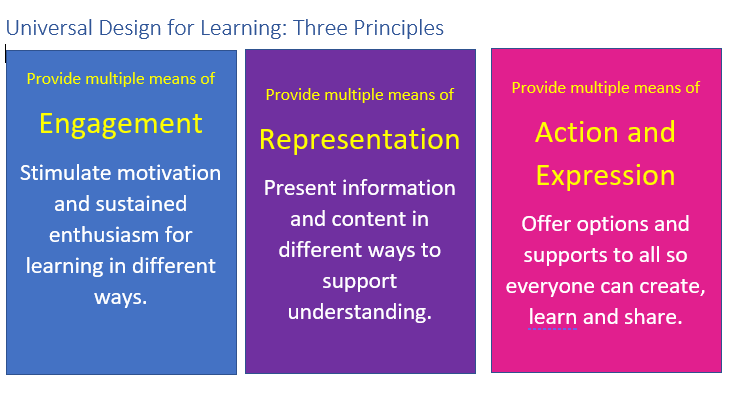
May 19, 2023, by Helen Whitehead
Implementing UDL 1: Multiple means of Engagement
If you’ve read any of our previous blog posts on Universal Design for Learning (UDL) or encountered it somewhere else, then you’ll know there are three main principles of the UDL Framework, developed by CAST. Each UDL principle is designed to help academics and others involved in teaching to improve how we present information, engage students and create inclusive assessment.
Multiple means of Engagement (the WHY of learning) asks: are learners challenged, interested and motivated about what they are learning?
Multiple means of Representation (the WHAT of learning) asks: is material and content (visual and auditory) presented in a variety of ways?
Multiple means of Action & Expression (the HOW of learning) asks: can learners express their comprehension and knowledge in multiple ways?
I’ve been collecting some ideas about what these principles could and do look like in our practice at the University.
The first principle we’ll look at is about multiple means of engagement: engaging learners in different ways, motivating and challenging them to learn. In an era when students seem to have less and less time available to study, and are tempted to take the easy way to pass courses, motivation to be interested in and enjoy learning is more important than ever.
What activities might promote this?
Here are some possible examples.
Provide clear scaffolding of learning:
- Design online modules in a way that minimises confusion.
- Use templates across a School for consistency.
- Follow the Moodle Everywhere guidelines for the minimum information to be found in every Moodle module in the university.
Make learning outcomes clear, and map sessions to the wider curriculum:
- In Moodle lay out clearly what students must do: so they know what’s expected of them.
- Use Announcements to remind learners of targets and timeframes.
Make yourself available in office hours:
- Advertise face-to-face office hours.
- Have online office hours: perhaps in Teams.
- Use email, with clear boundaries (to protect your time while still being available).
- Make use of asynchronous forums and FAQs to answer the same questions that come up over and over again.
Provide tasks that allow for active participation, critical engagement, exploration and experimentation.
- Encourage active learning using a variety of Moodle and other tools.
Engage learners in assessment and give prompt and informative feedback.
- A discussion forum can be used for general feedback, Turnitin/Moodle Assignments for personal feedback, and Quizzes for instant feedback
No comments yet, fill out a comment to be the first

Leave a Reply